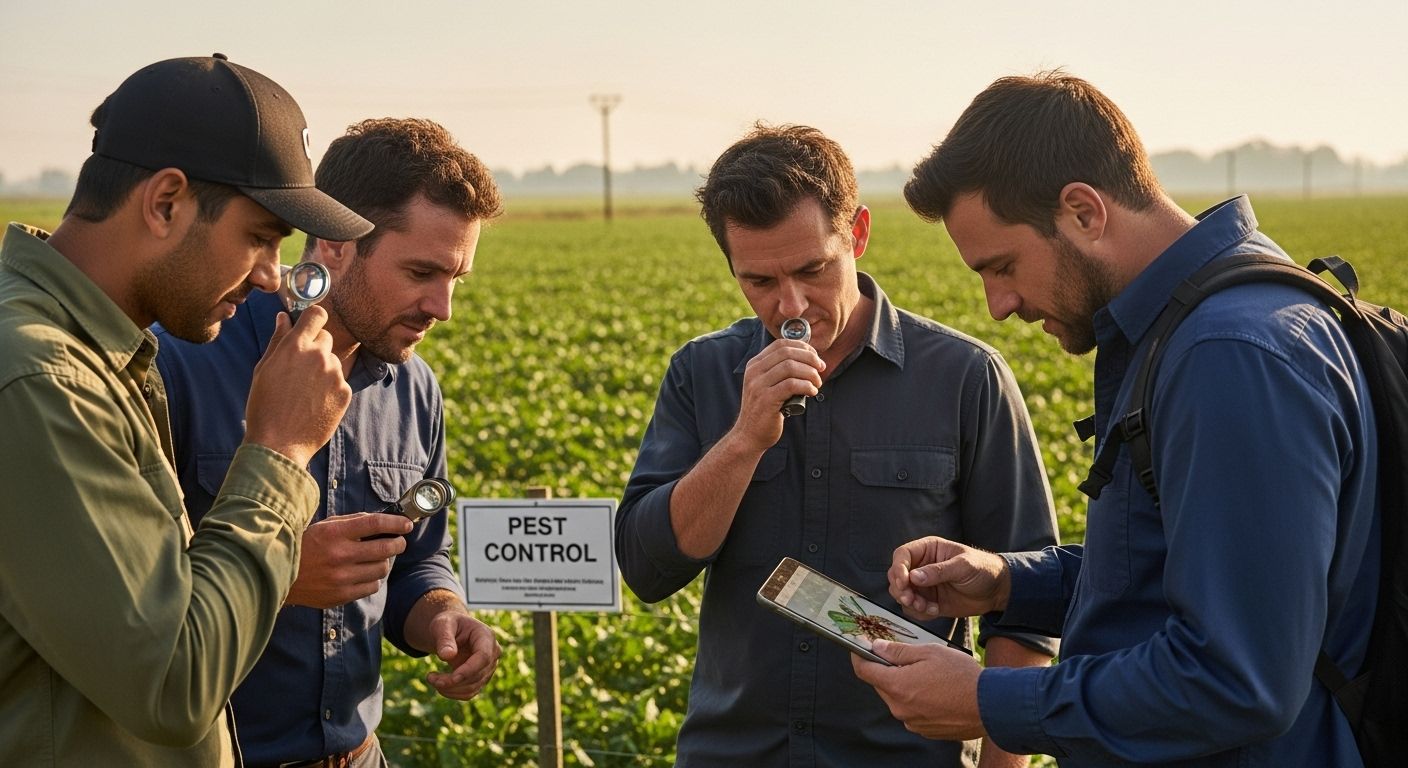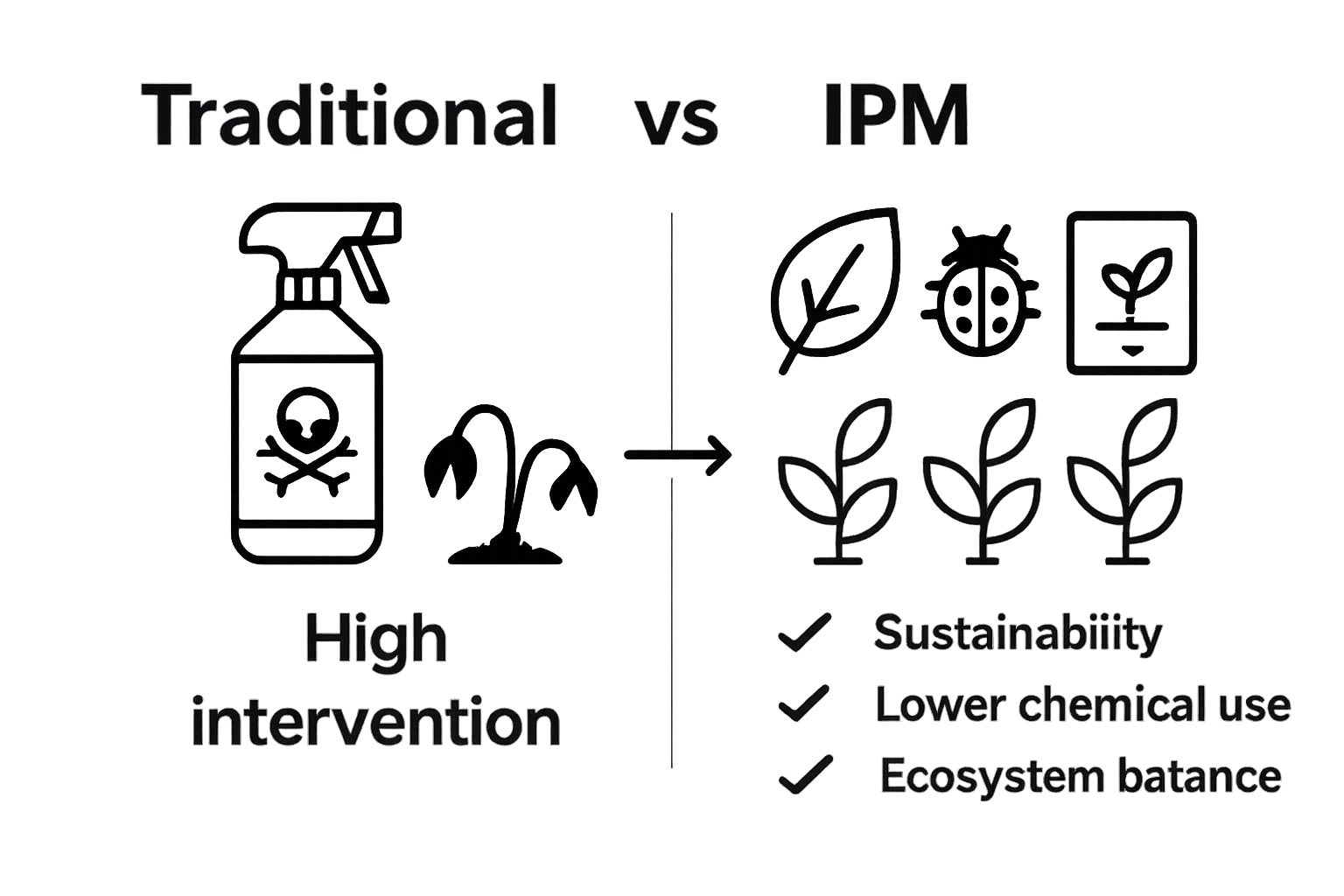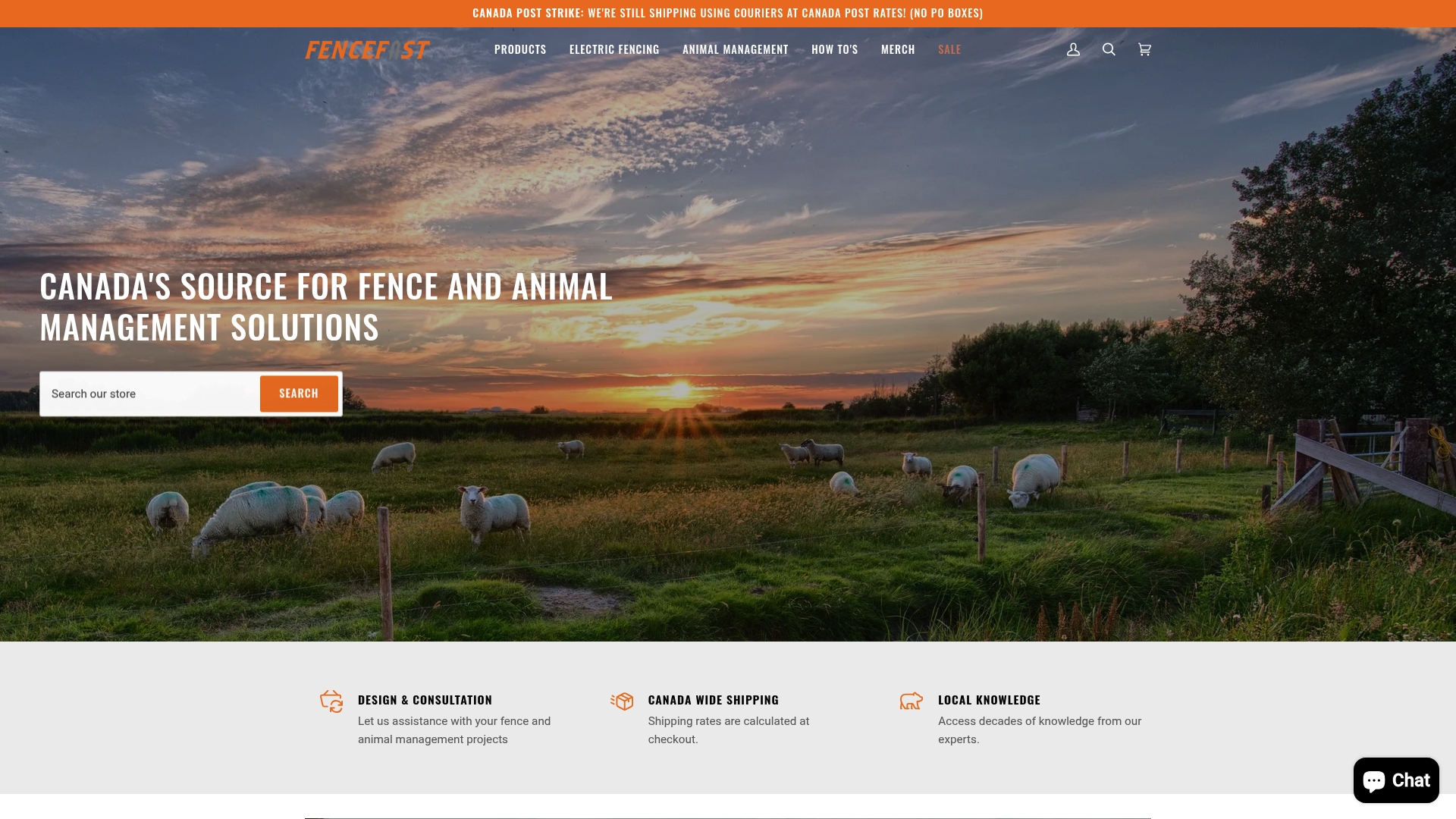Farmers have to battle pests every year and the stakes are sky high. Without effective pest control, crop losses from pests can exceed 20 percent annually. That sounds like a simple numbers game but there is more beneath the surface.

Some pests can actually benefit farms by helping pollinate crops or support soil health. So the real challenge is knowing which organisms to manage and when. This flips the whole idea of pest control from a war on all pests to a smart balancing act that keeps farms thriving.
Table of Contents
- What Is Pest Control On Farms And Why Is It Essential?
- The Role Of Pests In Agriculture: Benefits And Threats
- Key Methods Of Pest Control: Traditional Vs. Modern Approaches
- The Importance Of Integrated Pest Management (IPM) Strategies
- Economic And Environmental Impact Of Pest Control Practices
Quick Summary
| Takeaway | Explanation |
|---|---|
| Integrated Pest Management (IPM) is essential | IPM combines various strategies for sustainable pest control, balancing productivity and environmental concerns. |
| Understanding pests enhances management success | Recognizing pest species and their ecological roles allows for more informed and effective control measures. |
| Modern methods prioritize ecology and sustainability | Contemporary pest control techniques focus on precision and minimal chemical use, fostering ecosystem health. |
| Continuous monitoring is crucial | Regular assessment of pest populations helps farmers act promptly and strategically, preventing extensive crop damage. |
| | Economic impacts significantly influence pest strategies | Effective pest management directly correlates to economic sustainability, minimizing losses and optimizing resource allocation. |
What is Pest Control on Farms and Why is it Essential?
Pest control on farms represents a critical agricultural management strategy designed to protect crops, livestock, and overall agricultural productivity from destructive organisms. At its core, pest control involves systematically preventing, managing, and eliminating organisms that can cause significant economic damage or pose health risks to agricultural operations.
Understanding Agricultural Pest Challenges
Farmers face complex challenges from various pest types that threaten their livelihood. These pests range from insects and rodents to fungi, bacteria, and invasive plant species. Each category can devastate crops, reduce yield quality, and potentially contaminate food supplies. According to United States Department of Agriculture, crop losses from pests can exceed 20% annually without effective management strategies.
The Comprehensive Approach to Farm Pest Management
Modern pest control transcends simple elimination. Integrated Pest Management (IPM) emerges as a sophisticated ecological approach that balances economic feasibility with environmental responsibility. This strategy involves:
- Identifying specific pest species and understanding their life cycles
- Monitoring pest population dynamics
- Implementing targeted intervention methods
- Minimizing chemical intervention wherever possible
- Prioritizing biological and cultural control techniques
Successful pest control requires a holistic understanding of agricultural ecosystems. Farmers must recognize that not all organisms are harmful and that maintaining ecological balance is as crucial as eliminating destructive pests. By adopting scientifically informed, environmentally sensitive approaches, agricultural professionals can protect their investments while maintaining sustainable farming practices.
The Role of Pests in Agriculture: Benefits and Threats
While pests are often viewed negatively, their role in agricultural ecosystems is surprisingly complex. Some organisms classified as pests actually contribute to ecological balance, while others pose significant risks to crop production and food security. Understanding this nuanced relationship is crucial for effective agricultural management.
Ecological Impact of Agricultural Pests
Not all organisms labeled as pests are inherently destructive. Some play critical roles in agricultural ecosystems by supporting natural processes. According to Food and Agriculture Organization, certain insect populations contribute to pollination, soil health, and natural pest control mechanisms.
Quantifying Pest Threats to Agricultural Production
Despite potential ecological benefits, pests represent a substantial economic threat to global agriculture. Quantitative research reveals significant challenges in managing pest populations:
- Approximately 20-40% of global crop yields are lost annually due to pest damage
- Arthropods can destroy crop production valued at over USD 470 billion worldwide
- Different pest categories impact agricultural systems uniquely
Pest interactions within agricultural environments are dynamic and multifaceted. While some organisms can devastate crops, others serve as natural regulators of ecosystem balance. Farmers and agricultural professionals must develop sophisticated, nuanced strategies that recognize both the potential threats and ecological contributions of these complex organisms.
The following table organizes statistical data and key facts about the impact of pests on agriculture, helping summarize the challenges faced by farmers worldwide.
| Data Point | Value/Fact | Source/Details |
|---|---|---|
| Global crop losses due to pests (annual) | 20-40% | Food and Agriculture Organization |
| Economic loss (arthropod damage worldwide) | Over USD 470 billion | FAO |
| Crop loss from pests without management (US) | Over 20% annually | USDA |
| Pest types affecting agriculture | Insects, rodents, fungi, bacteria, weeds | Article content |
| Pest contributions to ecosystem | Pollination, soil health, natural control | Article content |
Key Methods of Pest Control: Traditional vs. Modern Approaches
Pest control methodologies have evolved dramatically, transitioning from broad, indiscriminate techniques to sophisticated, targeted strategies that prioritize ecological balance and sustainable agricultural practices. Understanding the progression of pest management approaches reveals the complex challenges farmers face in protecting their crops and livestock.
Traditional Pest Control Strategies
Historically, pest control relied heavily on chemical interventions and widespread pesticide application. Farmers would apply broad-spectrum chemicals across entire fields, attempting to eliminate all potential pest populations. These approaches often resulted in unintended consequences, including environmental contamination, pest resistance, and disruption of natural ecosystem balances.
To help clarify the differences between traditional and modern approaches to farm pest control, the following table compares their main features, practices, and impacts.
| Approach | Key Features | Typical Practices | Environmental Impact |
|---|---|---|---|
| Traditional Pest Control | Heavy chemical use, broad application | Widespread pesticide spraying | Higher risk of contamination |
| Modern Pest Management | Precision, ecological understanding, sustainability | Biological controls, monitoring, minimal chemicals | Reduced environmental impact |
| Integrated Pest Management (IPM) | Combines multiple strategies, ecosystem focus | Monitoring, targeted intervention, economic analysis | Prioritizes ecological balance |

Emerging Modern Pest Management Techniques
Contemporary pest control strategies emphasize precision, sustainability, and ecological understanding. According to the Environmental Protection Agency, modern approaches integrate multiple management techniques that go beyond chemical solutions:
- Biological Control: Introducing natural predators to manage pest populations
- Cultural Practices: Modifying farming techniques to create less hospitable environments for pests
- Genetic Resistance: Developing crop varieties naturally resistant to specific pest threats
- Precision Monitoring: Using advanced technologies to track and predict pest movements
Integrated Pest Management (IPM) represents the pinnacle of modern pest control philosophy. This approach combines scientific understanding, technological innovation, and ecological sensitivity to develop comprehensive pest management strategies that minimize environmental impact while protecting agricultural productivity.
The Importance of Integrated Pest Management (IPM) Strategies
Integrated Pest Management (IPM) represents a transformative approach to agricultural pest control, moving beyond traditional reactive methods toward a proactive, holistic ecosystem management strategy. This comprehensive framework addresses pest challenges through intelligent, scientifically informed interventions that balance economic productivity with environmental sustainability.
Foundational Principles of IPM
At its core, IPM is not simply about eliminating pests, but understanding and managing entire agricultural ecosystems. This approach recognizes that pests are part of complex ecological interactions and require nuanced, strategic responses. Farmers using IPM focus on long-term prevention strategies rather than immediate, potentially destructive interventions.
Strategic Components of Effective IPM
According to the United States Department of Agriculture, successful IPM strategies incorporate multiple sophisticated management techniques:
- Continuous Monitoring: Regular assessment of pest populations and environmental conditions
- Ecological Understanding: Comprehending pest life cycles and ecosystem interactions
- Targeted Interventions: Implementing precise, minimal-impact control methods
- Economic Considerations: Balancing pest management costs with potential crop losses
IPM represents a paradigm shift in agricultural pest management, transforming traditional approaches from broad chemical treatments to intelligent, adaptive strategies.

By prioritizing ecological balance and scientific understanding, farmers can develop more resilient, sustainable agricultural systems that protect both crop yields and environmental health.
Economic and Environmental Impact of Pest Control Practices
Pest control practices represent a complex intersection of economic sustainability and environmental stewardship. Agricultural professionals must navigate intricate challenges that balance crop protection, financial viability, and ecological preservation. Understanding the multifaceted implications of pest management strategies is crucial for developing responsible agricultural practices.
Economic Considerations in Pest Management
Pest control directly influences agricultural economic performance. Ineffective pest management can lead to substantial crop losses, while overly aggressive interventions can result in unnecessary expenses. Farmers must develop nuanced strategies that optimize resource allocation and minimize financial risks associated with pest damage and control methods.
Environmental Consequences of Pest Control
According to the USDA Natural Resources Conservation Service, sustainable pest management practices can significantly reduce environmental contamination and preserve ecosystem health. The ecological footprint of pest control extends far beyond immediate agricultural landscapes:
- Reduced chemical runoff into water systems
- Preservation of beneficial insect populations
- Maintenance of soil microorganism diversity
- Protection of surrounding wildlife habitats
Ecological intensification emerges as a critical paradigm in modern agricultural pest management. By prioritizing natural pest regulation services and implementing targeted, minimal-intervention approaches, farmers can simultaneously protect crop yields, reduce environmental impact, and maintain long-term agricultural sustainability. The goal is not complete pest elimination, but creating balanced, resilient agricultural ecosystems that can naturally resist and manage potential pest threats.
Protect Your Farm with Smart Pest Control Solutions
If you struggle with pests damaging your crops and threatening your livestock, you know the challenge goes beyond just elimination. As explained in our article, successful pest management means understanding the full ecosystem, using Integrated Pest Management (IPM) strategies, and adopting practical tools that put you back in control. Many farmers face the constant pressure of crop loss, economic risk, and rising costs when traditional pest approaches fall short.

Let FenceFast.ca help you build a stronger defense. With our expert support and broad selection of fencing and animal management products, you can create boundaries that keep harmful wildlife away from your fields and pastures. Our precision electric fencing systems and RFID livestock monitoring solutions offer reliable protection while supporting sustainable, eco-friendly pest management. Visit FenceFast.ca today to explore our product catalog, schedule a consultation, or shop for farm supplies that help preserve your yields and peace of mind. Take the next step toward better pest control and protect your investment before the next season begins.
Frequently Asked Questions
What is the purpose of pest control on farms?
Pest control on farms aims to protect crops and livestock from destructive organisms that can cause economic damage and pose health risks. It involves preventing, managing, and eliminating pests to ensure agricultural productivity.
What are Integrated Pest Management (IPM) strategies?
Integrated Pest Management (IPM) is an ecological approach to pest control that combines various methods, including biological control, cultural practices, and genetic resistance, to manage pests sustainably while minimizing environmental impact.
How can pests affect agricultural production?
Pests can lead to significant crop losses, often between 20-40% of global yields annually. They can reduce crop quality and contaminate food supplies, presenting substantial economic threats to agriculture.
What are some modern methods of pest control?
Modern pest control methods include biological control with natural predators, cultural techniques to create unfavorable conditions for pests, and precision monitoring technologies to track pest populations and their movements.
Recommended
-
[
7L Mini Power Reel – FenceFast Ltd.
-
[
Best Fencing for Cattle: Top Choices and Tips for 2025 – FenceFast Ltd.
](https://fencefast.ca/blogs/news/best-fencing-for-cattle-top-choices-2025)
-
[
Predator Proof Chicken Coops: 2025 Guide for Safe Flocks – FenceFast Ltd.
](https://fencefast.ca/blogs/news/predator-proof-chicken-coops-2025-guide)
-
[
Gallagher Garden & Backyard Protection Kit – FenceFast Ltd.
